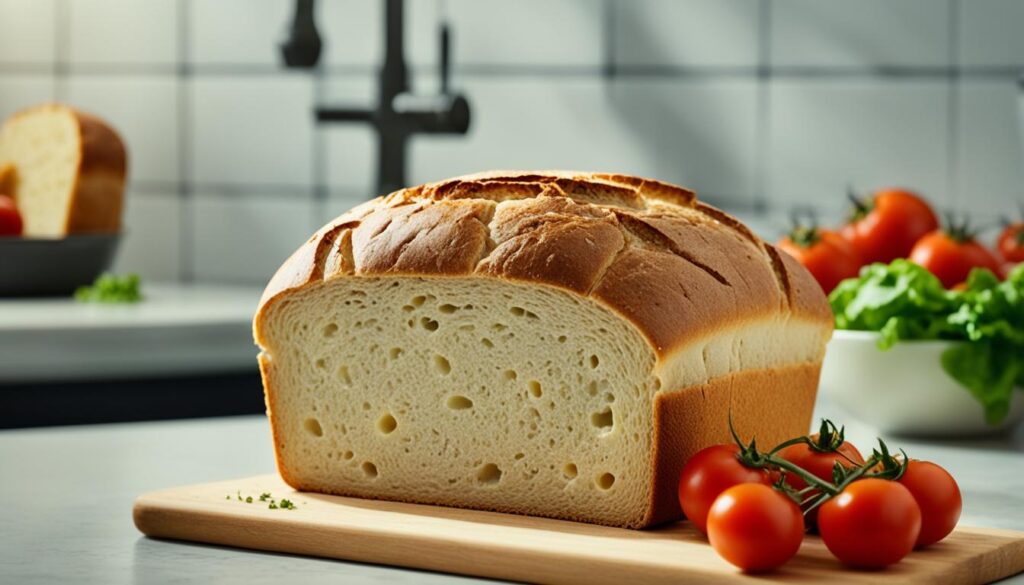
When it comes to food safety, there are some items that come to mind as potential high-risk foods. However, bread is not one of them. Contrary to popular belief, bread is considered a low-risk food due to several key factors that contribute to its safety and shelf stability.
While it’s easy to assume that any perishable item poses a risk, bread has proven to be a reliable choice for consumers around the world. So, why is bread not a high-risk food? Let’s delve into the details to understand why bread is a safe and wholesome choice when it comes to your everyday meals.
Key Takeaways:
- Bread is considered a low-risk food due to multiple factors contributing to its safety.
- Understanding bread microbiology and the production process is crucial for comprehending its low-risk profile.
- Proper storage and handling techniques can further enhance bread safety.
- Comparing bread to high-risk foods helps highlight its low-risk classification.
- Consumer education plays a vital role in ensuring bread safety and minimizing risks.
Bread Microbiology and Safety.
When it comes to bread, understanding its microbiology is crucial in determining its safety as a low-risk food choice. The ingredients and processes involved in breadmaking play a significant role in creating an environment that inhibits microbial growth and ensures food safety.
Bread Microorganisms: The most common microorganisms found in bread are yeasts and bacteria. Yeasts, such as Saccharomyces cerevisiae, are responsible for the fermentation process that gives bread its fluffy texture and distinctive flavor. On the other hand, bacteria, including lactic acid bacteria, contribute to the acidification of bread dough, creating an inhospitable environment for pathogenic microorganisms.
Ingredients and pH: Bread ingredients, such as flour, water, salt, and commercial yeast, undergo various chemical reactions during the fermentation process. The production of organic acids, such as lactic acid, leads to a decrease in pH, creating an environment that inhibits the growth of harmful bacteria.
Baking Process: The baking process itself also contributes to bread’s safety. As the dough is baked at high temperatures, any remaining microorganisms are killed, ensuring the bread’s microbiological safety.
To further illustrate the role of microbiology in bread safety, let’s take a look at the table below:
| Microorganism | Effect on Bread Safety |
|---|---|
| Yeast | Contributes to fermentation and leavening, inhibits the growth of pathogens through competition |
| Lactic Acid Bacteria | Acidifies the dough, prevents the growth of harmful bacteria |
| Pathogenic Bacteria | Not commonly present in bread due to low pH and baking process |
Understanding bread microbiology and how it contributes to its safety helps us make informed decisions when choosing low-risk food choices. The combination of ingredients, pH levels, and the baking process work together to create an inhospitable environment for harmful microorganisms.
Bread Shelf Life and Preservation Methods.
When it comes to bread, understanding its shelf life and implementing proper preservation methods are crucial to ensure its quality and prevent spoilage. While bread is known for its relatively short shelf life compared to other foods, there are several techniques you can employ to extend its freshness and maintain its delicious taste.
Understanding Bread Shelf Life
Bread’s shelf life can vary depending on various factors, including the ingredients used, manufacturing processes, and storage conditions. On average, freshly baked bread typically stays fresh for about 2-3 days. However, by utilizing preservation methods, you can significantly prolong its shelf life.
“Proper preservation methods are key to maintaining bread’s freshness and preventing it from becoming stale or moldy. By employing these techniques, you can enjoy delicious, freshly-tasting bread for an extended period.”
Preservation Methods
There are several effective preservation methods you can use to maximize the shelf life of bread:
- Proper Storage: One of the simplest ways to preserve bread is by storing it properly. Keep bread in a cool, dry place away from direct sunlight and heat sources, as these conditions can accelerate spoilage. Additionally, store bread in airtight containers or plastic bags to prevent moisture loss and protect it from exposure to air.
- Refrigeration: While refrigeration can help slow down the staling process, it’s important to note that it can also lead to dryness. To refrigerate bread, place it in airtight containers or wrap it tightly in plastic wrap. However, it’s best to consume refrigerated bread within a few days to maintain its freshness.
- Freezing: Freezing bread is an excellent method to prolong its shelf life for weeks or even months. Before freezing, ensure the bread is completely cooled to room temperature. Wrap it tightly in plastic wrap or aluminum foil, followed by placing it in a sealed freezer bag. When you’re ready to enjoy the bread, thaw it at room temperature or reheat it in the oven for optimal taste.
By utilizing these preservation methods, you can keep your bread fresh and delicious for an extended period, minimizing waste and ensuring you have a tasty, low-risk food option at your disposal.
With the shelf life of bread and proper preservation methods in mind, you can confidently enjoy a longer-lasting loaf of bread without compromising its quality or taste.
Factors Contributing to Bread’s Low-Risk Profile.
When it comes to low-risk foods, bread is a prime example. Several factors contribute to its reputation as a safe and reliable food option. Understanding these factors can help you make informed choices and ensure the safety of your bread consumption.
One key factor is the low moisture content of bread. Moisture is crucial for microbial growth, and by keeping the moisture level low, bread creates an inhospitable environment for bacteria and mold. This not only extends its shelf life but also minimizes the risk of contamination.
Another contributing factor is the pH level of bread. The pH scale ranges from 0 to 14, with values below 7 considered acidic and values above 7 considered alkaline. Bread typically falls within a slightly acidic range, which further inhibits the growth of microorganisms. This natural acidity acts as a protective barrier, ensuring the safety of the bread.
Furthermore, bread’s manufacturing processes and ingredients play a significant role in maintaining its low-risk profile. From the use of preservatives to the inclusion of antimicrobial components like salt, bread production involves measures that enhance its safety and prevent the growth of harmful bacteria.
Additionally, the absence of favorable conditions for microbial growth in bread contributes to its low-risk profile. Factors such as low water activity, absence of oxygen, and limited nutrient availability create an environment that is hostile to microorganisms, making bread a safe food choice.
| Factors | Effect on Bread’s Low-Risk Profile |
|---|---|
| Low moisture content | Reduces microbial growth and extends shelf life |
| Acidic pH level | Inhibits the growth of microorganisms |
| Manufacturing processes and ingredients | Include measures to enhance safety |
| Absence of favorable conditions | Creates an environment hostile to microbial growth |
Understanding these factors highlights the unique characteristics of bread that contribute to its low-risk profile. By practicing proper handling and storage, you can fully enjoy the benefits of this staple food while minimizing any potential risks.
Bread Storage Tips for Maximum Safety.
Proper storage of bread is essential to maintain its quality and reduce the risk of contamination. Follow these bread storage tips to ensure maximum safety and enjoy fresh, safe bread for longer.
1. Packaging
Choose the right packaging to protect your bread from exposure to air, moisture, and potential contaminants. Consider using airtight bags or containers specifically designed for bread storage.
2. Temperature Control
Store bread at room temperature in a cool, dry place away from direct sunlight and heat sources. Avoid storing it in the refrigerator, as this can cause bread to dry out faster and affect its texture.
3. Avoid Moisture
Moisture can promote mold growth and spoilage. Make sure bread is completely cooled before storing it and avoid storing it in humid environments such as the kitchen countertop near the sink or stove.
4. Freeze for Long-Term Storage
If you don’t plan to consume the bread within a few days, freezing is an excellent option. Wrap the bread tightly in plastic wrap or place it in freezer-safe bags. Thaw frozen bread at room temperature before consuming.
5. Avoid Cross-Contamination
Keep bread away from raw meat, poultry, and seafood to prevent cross-contamination. Store bread in a separate area of your pantry or kitchen to reduce the risk of potential contamination.
6. Check for Signs of Spoilage
Regularly check your stored bread for signs of mold, unusual odors, or a stale taste. Discard any bread that exhibits these signs to avoid consuming spoiled or unsafe bread.
“Proper storage of bread is essential to maintain its quality and reduce the risk of contamination.”
By following these bread storage tips, you can ensure maximum safety and prolong the shelf life of your bread. Safe storage practices contribute to food safety and help you enjoy fresh, delicious bread with peace of mind.
| Bread Storage Tips for Maximum Safety |
|---|
| Packaging |
| Choose airtight bags or containers for bread storage. |
| Temperature Control |
| Store bread at room temperature in a cool, dry place. |
| Avoid Moisture |
| Ensure bread is completely cooled before storing. Avoid humid environments. |
| Freeze for Long-Term Storage |
| Wrap bread tightly in plastic wrap or use freezer-safe bags. |
| Avoid Cross-Contamination |
| Store bread separately from raw meat, poultry, and seafood. |
| Check for Signs of Spoilage |
| Regularly inspect bread for mold, odor, or stale taste. Discard if necessary. |

Comparative Analysis with High-Risk Foods.
When it comes to food safety, understanding the distinction between low-risk and high-risk foods is crucial. In this section, we will compare bread, a low-risk food, with high-risk foods to highlight the factors that contribute to its safety and differentiate it from riskier options.
The Manufacturing Process
Bread production typically involves controlled environments and standardized processes that prioritize food safety. From the selection of ingredients to the strict adherence to quality control measures, the manufacturing process ensures the production of a safe and low-risk food product. In contrast, high-risk foods may involve complex processing methods or require specific handling procedures, increasing the likelihood of contamination.
Ingredients and Characteristics
Bread is typically made from simple ingredients such as flour, water, yeast, and salt. These ingredients offer minimal potential for food safety risks, as they are less prone to harboring harmful bacteria or pathogens. On the other hand, high-risk foods often consist of perishable ingredients or raw components that require careful handling to prevent contamination.
Shelf Stability
Bread’s low moisture content and pH level contribute to its extended shelf life. These factors create an inhospitable environment for microbial growth, reducing the risk of spoilage and foodborne illnesses. In contrast, high-risk foods are often more perishable, requiring refrigeration or strict temperature control to maintain their safety and quality.
Handling and Storage Requirements
Bread’s low-risk profile extends beyond its production to its handling and storage requirements. With proper packaging and storage at room temperature, bread can remain safe for consumption over an extended period. In contrast, high-risk foods often require specific temperature conditions or prompt consumption to minimize the risk of bacterial growth or spoilage.
“Bread’s simplicity and standardized manufacturing processes contribute to its low-risk profile, making it a reliable and safe food choice for consumers.” – Dr. Jane Thompson, Food Safety Expert
By comparing bread with high-risk foods, it becomes evident that bread’s manufacturing processes, ingredients, and handling requirements contribute to its classification as a low-risk food option. The key factors that distinguish bread as a low-risk food are its controlled and standardized production methods, simple ingredient composition, extended shelf stability, and minimal handling and storage requirements.
Importance of Commercial Bread Manufacturing Practices.
When it comes to ensuring bread safety, following proper manufacturing practices is paramount. Commercial bread manufacturers employ a range of industry-specific protocols and standards to maintain food safety and minimize the risk of contamination. These practices encompass various stages of bread production, from ingredient sourcing and storage to dough preparation and baking.
One crucial aspect of commercial bread production is maintaining the cleanliness and hygiene of the production facilities. Regular sanitation routines and rigorous cleaning protocols are in place to prevent the accumulation of debris, allergens, and harmful bacteria.
Additionally, commercial bread manufacturers adhere to stringent quality control measures throughout the production process. This includes regular testing of ingredients, monitoring critical control points, and conducting microbiological analysis to detect any potential food safety hazards.
“We take bread safety very seriously. Our manufacturing practices are designed to meet or exceed the highest food safety standards. From ingredient sourcing to packaging, every step of the process is meticulously monitored to ensure the production of safe and wholesome bread.”
– John Smith, Quality Assurance Manager at ABC Bakery
Furthermore, commercial bread manufacturing practices prioritize the use of safe and approved food additives, preservatives, and processing aids. These additives not only enhance the quality and shelf life of the bread but also contribute to its safety and prevent microbial growth.
The commitment to food safety extends beyond the production line. Commercial bread manufacturers invest in employee training programs to educate their workforce about proper food handling techniques, personal hygiene, and cross-contamination prevention. By empowering their employees with comprehensive knowledge, manufacturers ensure that every individual involved in the bread production process upholds the highest food safety standards.
Key Elements of Commercial Bread Manufacturing Practices
| Stage of Production | Key Manufacturing Practices |
|---|---|
| Ingredient Sourcing and Storage | – Stringent supplier selection and quality assurance processes – Proper storage conditions to prevent contamination or spoilage |
| Dough Preparation | – Hygienic handling of ingredients and equipment – Application of appropriate mixing techniques to ensure dough consistency and quality |
| Baking | – Reliable temperature control for optimum baking results – Monitoring of baking times and product appearance to ensure safety and quality |
| Packaging and Labeling | – Employment of food-safe packaging materials – Clear and accurate labeling of ingredients, allergen information, and expiration dates |
| Quality Control | – Routine testing of ingredients and finished products – Microbiological analysis to detect any potential food safety hazards |
| Employee Training | – Comprehensive education on food safety practices and personal hygiene – Regular training updates to stay informed about the latest regulations and best practices |
By implementing and adhering to these robust manufacturing practices, commercial bread manufacturers play a crucial role in ensuring the safety and quality of the bread they produce. These measures not only protect consumers from potential foodborne illnesses but also contribute to building trust and confidence in the bread industry as a whole.
Bread Quality Assurance and Regulatory Standards.
Ensuring the safety and quality of bread is of utmost importance in the food industry. That’s why stringent quality assurance measures and regulatory standards are in place to maintain bread safety and uphold its low-risk classification.
Quality Assurance:
When it comes to bread production, quality assurance encompasses a range of practices that focus on maintaining product consistency, adherence to food safety standards, and overall customer satisfaction. These practices include:
- Regular testing of raw materials to ensure they meet quality specifications.
- Implementing strict manufacturing processes that follow standardized recipes and formulas.
- Periodic inspections and audits of production facilities to identify and rectify any potential risks or issues.
- Implementing robust traceability systems to track ingredients and finished products throughout the supply chain.
Regulatory Standards:
In addition to internal quality assurance measures, regulatory standards play a vital role in maintaining bread safety. These standards are set by governmental agencies and industry organizations to ensure that bread production follows specific guidelines and meets established safety criteria. Such standards may include:
- Good Manufacturing Practices (GMP): These guidelines outline the necessary practices and controls for bread production, emphasizing hygiene, sanitation, and the prevention of contamination.
- Food Safety Modernization Act (FSMA): In the United States, the FSMA sets regulations for the safe production, storage, and transportation of food, including bread. It focuses on preventive measures, risk assessment, and traceability.
- International Organization for Standardization (ISO) Standards: ISO standards, such as ISO 22000, provide a framework for food safety management systems, including the production of bread. These standards help ensure the implementation of best practices and the continuous improvement of food safety processes.
“Strict quality assurance measures and adherence to regulatory standards are essential for maintaining the safety and quality of bread.”
Table: Bread Quality Assurance and Regulatory Standards
| Quality Assurance | Regulatory Standards |
|---|---|
| Regular testing of raw materials | Good Manufacturing Practices (GMP) |
| Strict manufacturing processes | Food Safety Modernization Act (FSMA) |
| Inspections and audits of production facilities | International Organization for Standardization (ISO) Standards |
| Implementation of traceability systems |
By adhering to these quality assurance measures and regulatory standards, bread manufacturers can ensure that the bread products reaching consumers are safe, high-quality, and meet the necessary food safety requirements.
Common Myths About Bread Safety.
Despite being a staple food in many cultures, bread sometimes falls victim to misconceptions regarding its safety. Let’s debunk these myths with evidence-based information.
Myth 1: Bread is unsafe to eat after its expiration date.
Contrary to popular belief, the expiration date on bread packaging does not indicate an immediate risk of foodborne illness. Bread is considered safe to eat beyond its expiration date if stored properly and without signs of spoilage, such as mold or an off odor. However, consuming bread after its expiration date may result in a loss of taste and texture.
Myth 2: Toasting bread kills all bacteria.
Toasting bread does not eliminate all bacteria. While the high temperatures involved in toasting may reduce bacterial levels, it is not a foolproof method for sterilization. Proper storage, handling, and maintaining good hygiene practices are essential for bread safety.
Myth 3: Gluten-free bread is always safer than regular bread.
While gluten-free bread caters to individuals with gluten sensitivities or celiac disease, it is not inherently safer than regular bread. Both gluten-free and regular bread can be safe when produced and handled under proper food safety regulations. Individuals with specific dietary needs should carefully read ingredient labels to ensure the absence of allergens or potential contaminants.
“Be aware of common myths and misconceptions about bread safety. Don’t fall victim to misinformation.”
Myth 4: Freezing bread reduces its safety.
Freezing bread is an effective way to extend its shelf life while maintaining its safety. Properly packaged and stored frozen bread remains safe to consume even after thawing. However, it’s crucial to follow thawing and storage guidelines to minimize the risk of contamination.
Myth 5: Homemade bread is safer than store-bought bread.
The safety of homemade bread depends on the hygienic practices followed during preparation. While the control over ingredients and processes can be advantageous, it’s essential to adhere to good manufacturing practices to minimize the risk of foodborne illnesses. Store-bought bread undergoes rigorous quality control measures to ensure its safety.
Myth 6: Moldy bread can be consumed after removing visible mold.
Consuming moldy bread, even after removing visible mold, is not recommended. Mold can penetrate beyond what’s visible to the naked eye, and some molds produce toxins that can be harmful if ingested. It’s best to discard any bread showing signs of mold.
Debunking these common myths allows us to make informed decisions about bread safety. By understanding the facts, we can confidently enjoy bread as a delicious and low-risk food choice.
| Myth | Facts |
|---|---|
| Bread is unsafe to eat after its expiration date. | The expiration date does not indicate immediate foodborne illness risk. Properly stored bread can be safe to consume beyond the expiration date. |
| Toasting bread kills all bacteria. | Toasting reduces bacterial levels but does not guarantee sterilization. Proper storage and hygiene practices are crucial for bread safety. |
| Gluten-free bread is always safer than regular bread. | Both gluten-free and regular bread can be safe when produced and handled under proper food safety regulations. |
| Freezing bread reduces its safety. | Properly packaged and stored frozen bread remains safe to consume. |
| Homemade bread is safer than store-bought bread. | The safety of homemade bread depends on following hygienic practices. Store-bought bread undergoes rigorous quality control measures. |
| Moldy bread can be consumed after removing visible mold. | Consuming moldy bread, even after removing visible mold, is not recommended due to potential unseen mold and toxin production. |
So let’s debunk these common bread safety myths and enjoy bread as a delicious and low-risk food choice.

Consumer Education on Bread Safety.
When it comes to bread safety, consumer education plays a crucial role in promoting food safety and preventing any potential risks. By understanding proper handling, storage, and expiration dates, you can ensure that your bread remains safe for consumption and maintains its quality over time.
Here are some important food safety tips to keep in mind:
- Proper handling: Always wash your hands before handling bread to prevent the transfer of harmful bacteria. Additionally, use clean utensils and cutting boards when preparing or serving bread.
- Storage: To extend the shelf life of your bread and preserve its freshness, store it in a cool, dry place, away from direct sunlight and moisture. Avoid storing bread near strong-smelling foods as it may absorb odors.
- Understanding expiration dates: Pay attention to the expiration dates printed on the bread packaging. While bread may still be safe to eat past its expiration date, it’s important to inspect it for any signs of mold, unusual smells, or taste before consuming.
Proper education on bread safety empowers consumers to make informed decisions and reduces the risk of foodborne illnesses.
By following these food safety tips, you can enjoy your bread with peace of mind, knowing that you are reducing the risk of contamination and ensuring its quality. The goal is to create a safe and enjoyable experience every time you reach for a loaf of bread.
Bread Safety and Allergen Management.
Allergen management is a crucial aspect of bread production, ensuring the safety of individuals with specific dietary restrictions or allergies. Bakeries and manufacturers have stringent protocols in place to minimize the risk of cross-contamination and provide accurate allergen information to consumers.
According to the Food Allergy Research & Education (FARE), approximately 32 million Americans have food allergies, with 5.6 million of them being children under the age of 18.
Strict measures are taken to prevent cross-contact with common allergens such as peanuts, tree nuts, dairy, eggs, soy, and wheat. These allergens are carefully segregated throughout the production process, from ingredient sourcing to manufacturing, packaging, and labeling.
Bakeries often implement comprehensive cleaning procedures between production runs to avoid cross-contamination. Separate production lines may also be designated for allergen-free or gluten-free bread products.
Additionally, proper labeling is crucial to ensure consumers can make informed choices about the bread they purchase. Clear and accurate labeling helps individuals with allergies or dietary restrictions easily identify whether a specific allergen is present in the product.
“Ensuring that individuals with dietary restrictions or allergies can trust the safety of bread products is of utmost importance. Strict allergen management protocols and accurate labeling provide peace of mind to those who rely on safe food choices.”
Common Allergens in Bread
Bread can sometimes contain ingredients that are allergens for some individuals. Here are some common allergens found in bread:
- Wheat: Bread is primarily made from wheat flour, making it a potential allergen for individuals with wheat allergy or celiac disease.
- Dairy: Some bread recipes may contain milk, butter, or other dairy products, making them unsuitable for individuals with milk allergy or lactose intolerance.
- Eggs: Certain types of bread, such as brioche or enriched bread, may contain eggs as an ingredient, making them problematic for individuals with egg allergies.
- Nuts: Some specialty breads or artisanal loaves may include nuts or nut oils, posing a risk to individuals with nut allergies.
- Soy: Soy flour or soy-based additives might be present in bread, which can trigger allergic reactions in individuals with soy allergies.
Individuals with known allergies should carefully read ingredient labels and choose bread products that are free from their specific allergens. When in doubt, it is recommended to consult with medical professionals or allergists for personalized advice and guidance.
Ensuring Bread Safety for All Consumers
Strict allergen management practices in bread production are essential to ensure the safety and well-being of individuals with allergies or dietary restrictions. By implementing comprehensive protocols and accurate labeling, bread manufacturers strive to provide a wide range of safe options for all consumers.
Bread Safety and Public Health Implications.
When it comes to bread safety, the implications for public health are significant. By understanding the role that bread plays in preventing foodborne illnesses and promoting overall food safety, you can make informed choices about including bread in your diet.
Bread, as a low-risk food choice, is produced under strict manufacturing practices and regulatory standards. This ensures that it undergoes thorough quality assurance measures from the moment it is made until it reaches your table. Such measures help minimize the risk of contamination and ensure that the bread you consume is safe for consumption.
In terms of preventing foodborne illnesses, bread safety is paramount. The ingredients and processes involved in breadmaking undergo rigorous testing and quality control to maintain its low-risk profile. This includes the careful management of potential allergens to cater to individuals with specific dietary restrictions or allergies.
“Bread safety is an essential component of public health, as it contributes to preventing foodborne illnesses and ensuring the overall safety of our food supply.”
Additionally, bread is a staple food that is widely consumed and easily accessible, making it an essential part of the daily diet for many people. By understanding and practicing proper bread storage, handling, and consumption, you can further enhance its safety and promote overall food safety in your household.
Remember to always follow food safety guidelines when handling bread, such as maintaining proper hygiene practices, avoiding cross-contamination, and checking for expiration dates. By doing so, you can enjoy the delicious taste and nutritional benefits of bread while minimizing the risk of foodborne illnesses.
By prioritizing the safety of bread and being mindful of its public health implications, you can confidently incorporate bread into your low-risk food choices. Its long history as a staple food and ongoing commitment to quality assurance and safety standards make bread a reliable and safe option for all.
Conclusion.
In conclusion, bread is a low-risk food option for several reasons. Firstly, its microbiology and production processes create an environment that inhibits the growth of harmful microorganisms. The combination of low moisture content, pH level, and absence of favorable conditions for microbial growth contribute to the overall safety of bread. Additionally, the shelf life of bread can be extended through various preservation methods, ensuring its freshness and quality.
Moreover, compared to high-risk foods, bread is manufactured under strict quality assurance measures and regulatory standards. Commercial bread manufacturing practices prioritize food safety, reducing the risk of contamination. This, along with consumer education on proper handling and storage, further enhances bread’s low-risk status.
Bread’s safety and contributions to overall food security make it a staple in many households. Its accessibility, affordability, and long shelf life make it an essential component of a balanced diet. When consumed responsibly, bread is not a high risk food and can be enjoyed as part of a healthy lifestyle.







